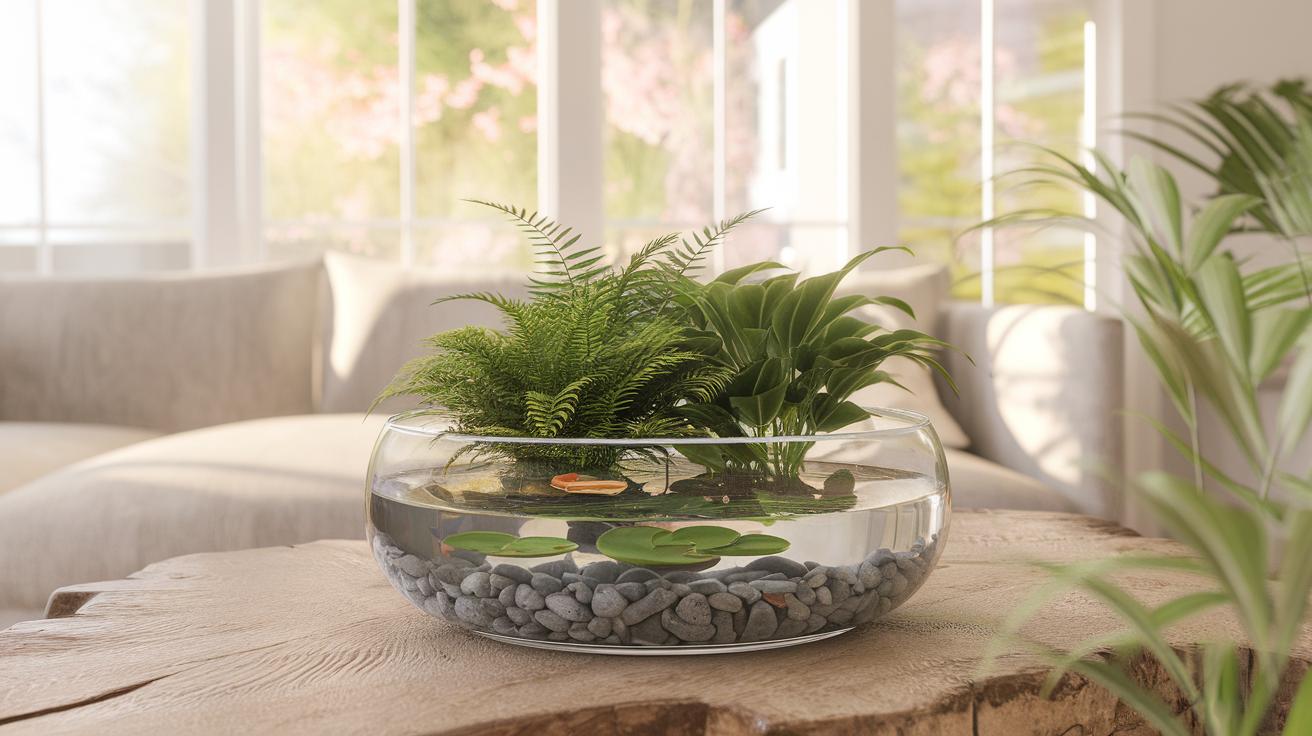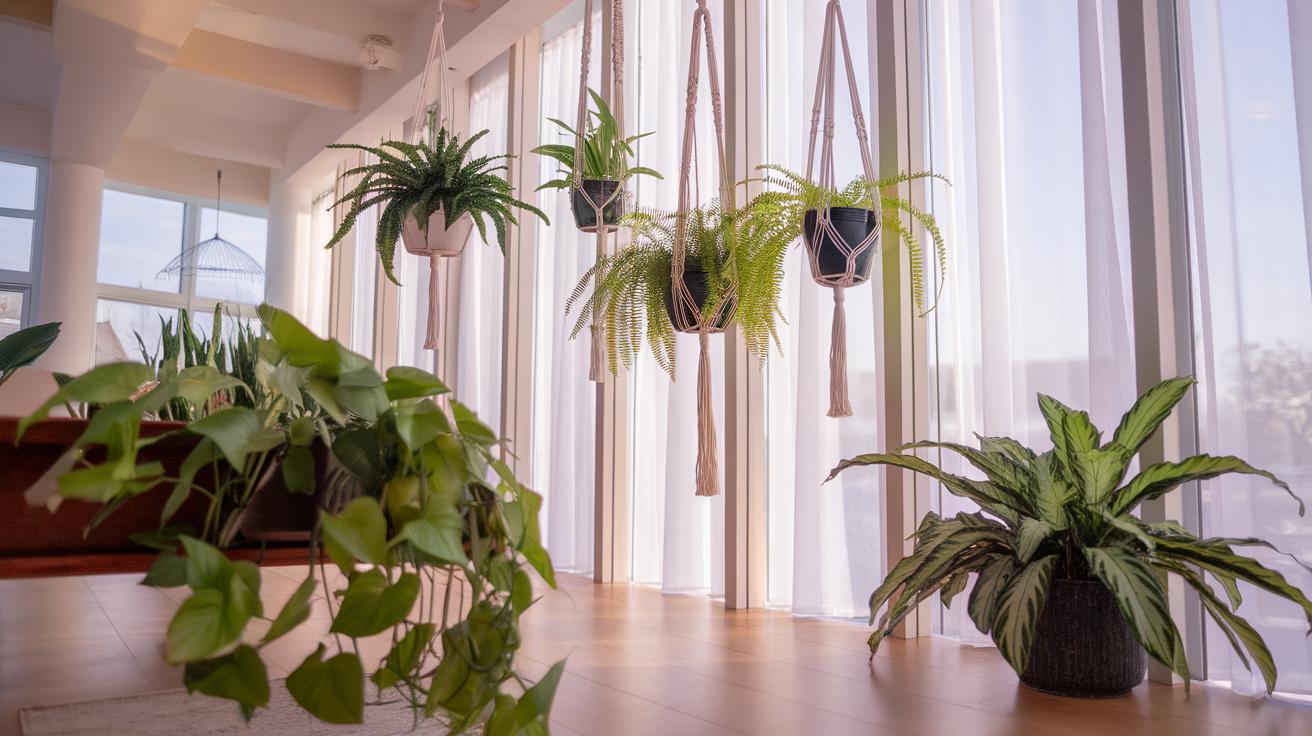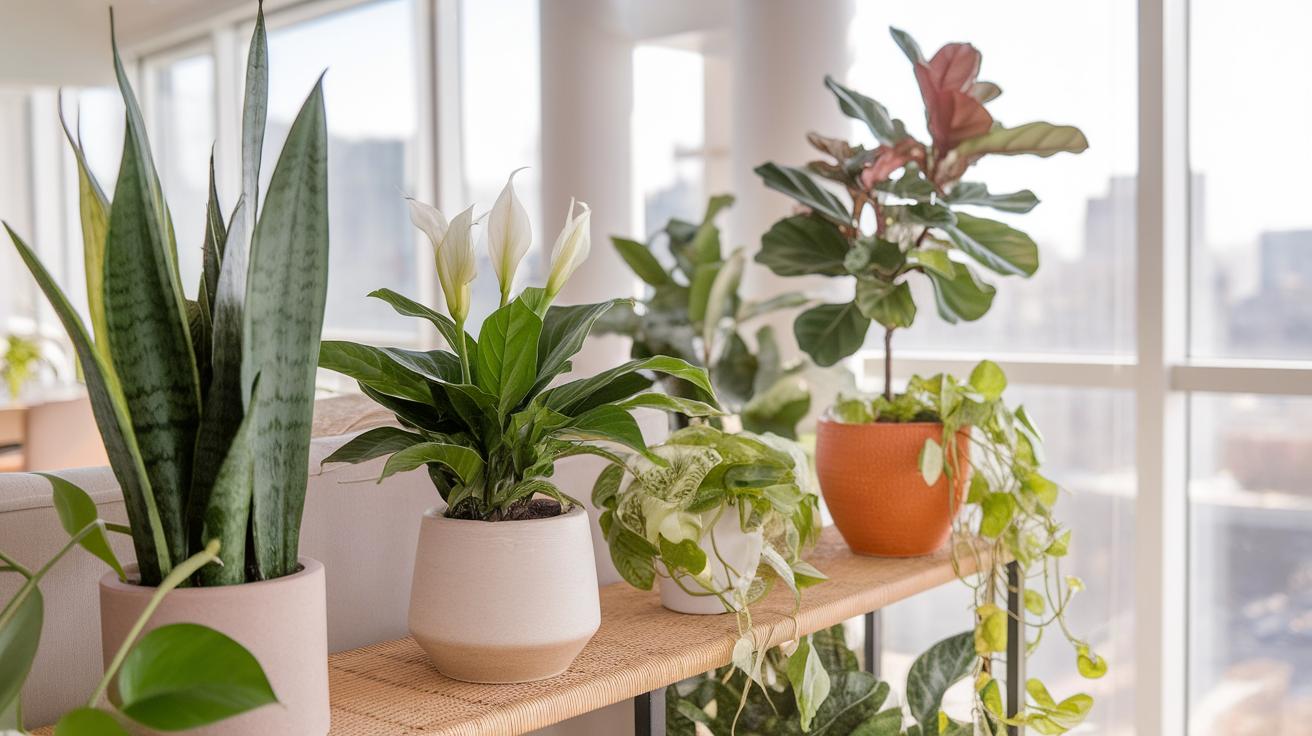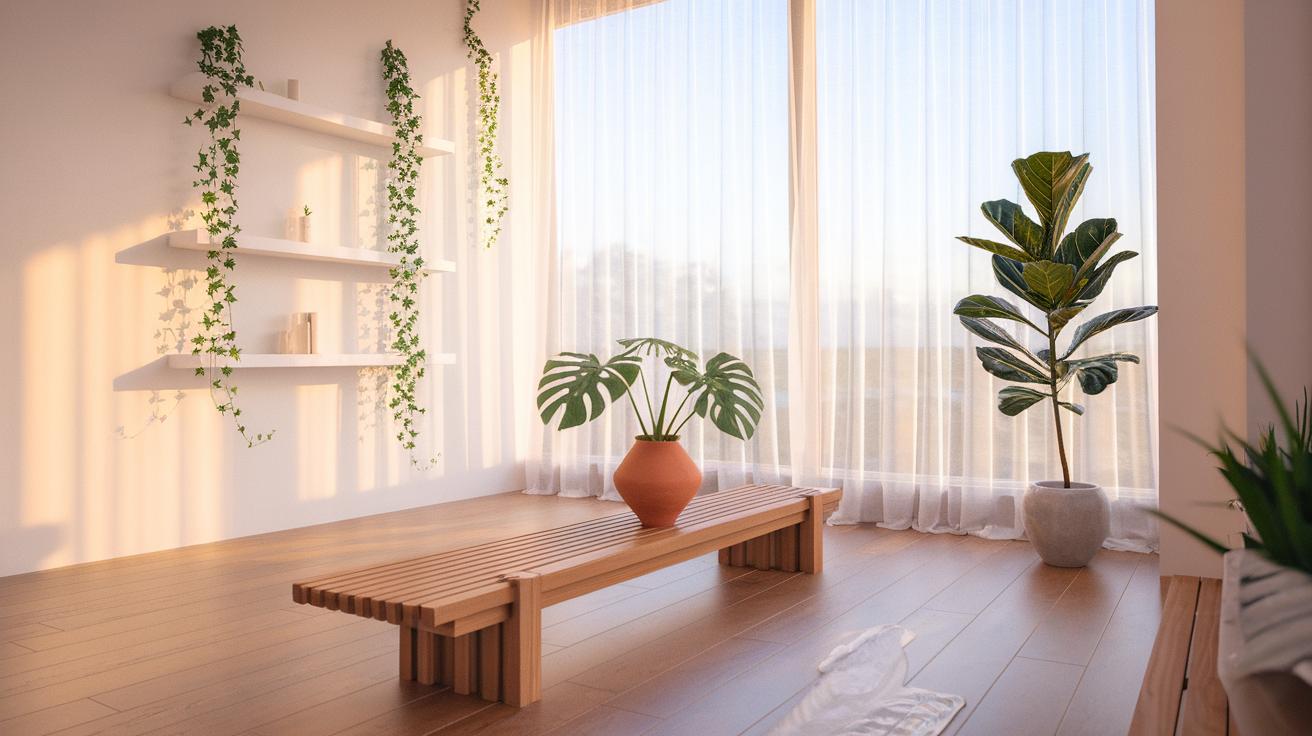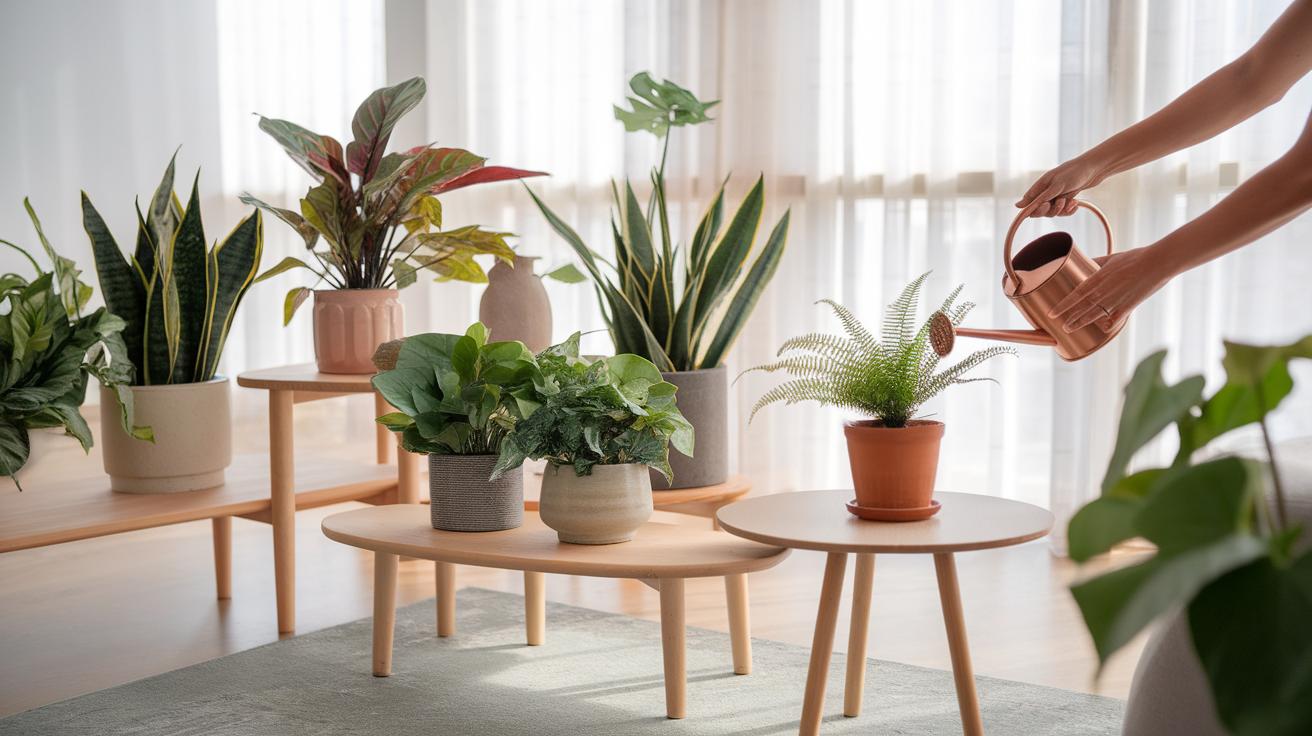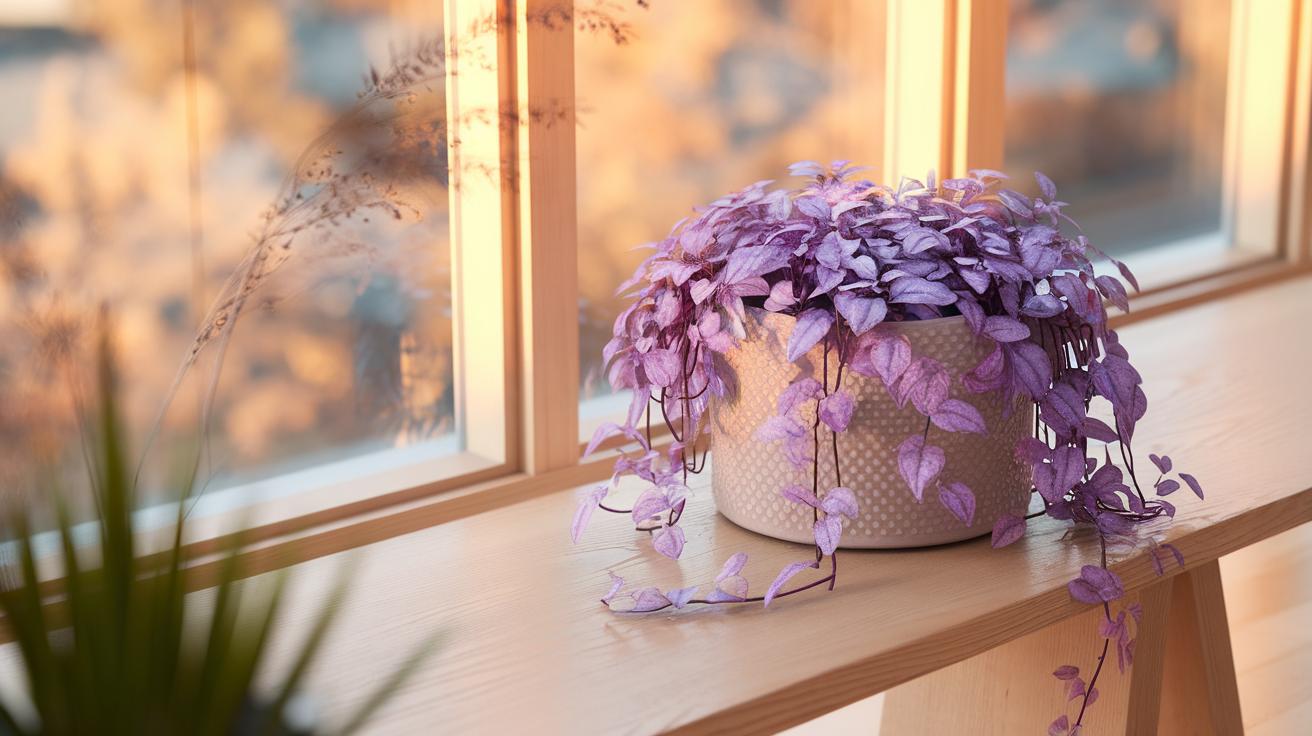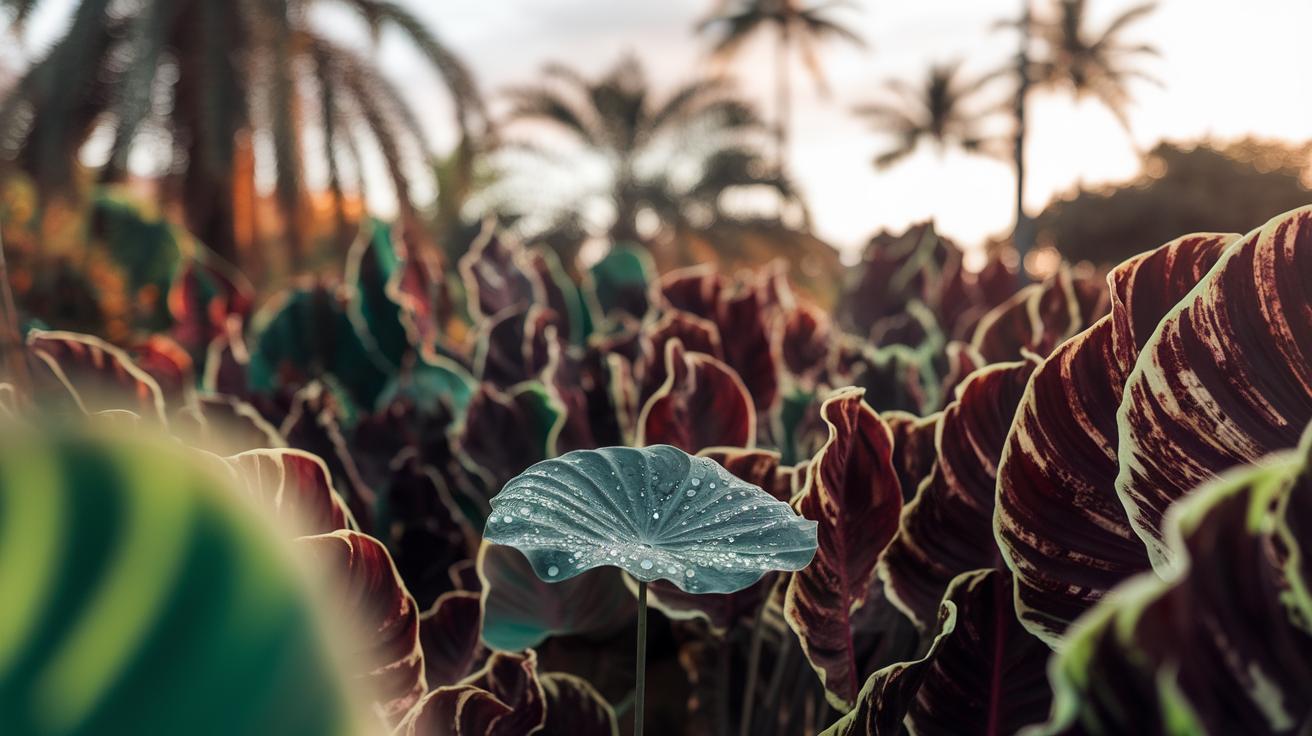Introduction
Indoor water gardens blend nature and water to bring a peaceful, natural feel into your living space. This gardening trend allows even beginners to create miniature ecosystems inside their homes. Water gardens add freshness to the air and offer a unique way to enjoy plants without the typical soil mess. You can design a space that suits your style and home environment with just a few materials.
Setting up an indoor water garden starts with choosing the right container and plants. You do not need a lot of experience to create a beautiful water garden. In this article, you will learn simple ideas and practical steps to make your own indoor water garden. The goal is to help you build a low-maintenance, visually appealing, and healthy space that you can enjoy every day.
Choosing the Right Container

Your container shapes the look and health of your indoor water garden. Choosing the right one helps plants grow well and keeps water clean. Containers must hold water without leaks and fit your available space.
Glass bowls offer crystal-clear views and work well for small water gardens. They’re easy to clean but can be fragile and limit size options. Aquariums give ample room and come with lids to control evaporation, but they can be heavy and bulky.
Ceramic pots hold water nicely and add artistic style. They often have drainage holes, which you’ll need to seal for water gardening. Recycled containers like old jars or buckets cut costs and reduce waste. Make sure they are waterproof and clean.
Pick a container size based on where you want to place it. A shallow, wide bowl suits a desk, while a tall aquarium fits well on a sturdy shelf. Think about your room’s style and how the container complements your décor. Which container matches your space and gardening goals?
Container materials and shapes
The material of your container affects durability and appearance. Glass is clear and shows water and roots beautifully, but breaks easily. Plastic lasts longer, is lightweight, and comes in many shapes, though it may scratch and look less natural.
Ceramic containers add color and texture. They can trap heat and may need sealing for water use. Metal containers look modern but risk rusting if not properly lined. Pick metal containers made for aquatic use to avoid damage.
Shape influences plant health and look. Wide, shallow containers help surface plants like water lilies. Tall, narrow ones fit rooted plants like lucky bamboo. Curved sides can limit planting space but look elegant. Think about how much room your plants need below and above water.
Sizing and placement tips
Your space guides container size. For a desk, a small bowl around 6–8 inches in diameter fits well without crowding. Larger tables or shelves can handle bigger tanks, providing room for more plants and decorations.
Choose a spot with stable light—near windows that get indirect sunlight works best. Too much direct sun may cause algae growth, while too little light stalls plant growth. Accessibility matters for cleaning and watering; avoid cramped corners.
Where will your water garden add the most charm and remain easy to care for? Think about daily habits and traffic flow in your home before picking a place. Proper location keeps your garden vibrant and your care routine simple.
Selecting Aquatic Plants

Choosing the right plants helps your indoor water garden thrive. Pick species that fit your space and care level.
Water lilies brighten the surface with their round leaves and blooms. They add elegance and help shade the water, reducing algae growth. They need 4-6 hours of light daily and calm water.
Pothos can grow in water and help keep the water clean by absorbing excess nutrients. Their trailing vines add a lush look. Place them where they get indirect light.
Lucky bamboo grows well in water and is known for its resilience. It requires minimal fuss and indirect, low light, making it good for dimmer rooms.
Java fern attaches to rocks or driftwood underwater. It needs low to medium light and can survive in varying water conditions.
Each plant plays a role in balancing your water garden. Which of these plants fit your available light and space?
Easy aquatic plants for beginners
Pick plants that recover quickly if you forget a watering or light day. Water lilies thrive in bright areas without much fuss.
Pothos grows fast and adapts to different light levels. You only need to change their water every couple of weeks.
Lucky bamboo tolerates low light and fewer water changes, perfect if you want a less demanding option.
Java fern can handle less light and changes in water quality, making it good for new growers.
Visual appeal ranges from broad lily pads to climbing pothos stems. Imagine how each plant shape and color fits your style.
Plant care essentials
Water your plants by topping off water regularly. Use filtered or distilled water to avoid chemicals harming plants.
Light matters. Water lilies need strong light, while lucky bamboo and Java fern grow with less. Adjust placement based on each plant’s needs.
Room temperature between 65-75°F keeps plants comfortable. Keep them away from heaters or drafts.
Change water every one to two weeks. This prevents build-up of nutrients that cause algae and keeps plants healthy.
Observe your plants. Are the leaves healthy and the colors bright? Adjust light and water if you notice yellowing or drooping.
Preparing Your Water Garden

Cleaning your container carefully helps avoid algae buildup and harmful bacteria that can affect your plants. Use a mild soap and warm water to wash the container, then rinse it thoroughly to remove any soap residue. Avoid harsh chemicals or abrasive tools that could damage the surface or leave toxic traces. Some enthusiasts soak new containers in water with a little vinegar to reduce contaminants before rinsing well.
Adding substrate or decorative stones creates a natural base for your aquatic plants. Choose materials like smooth river rocks, aquarium gravel, or specialized aquatic soil that won’t cloud the water. Layer these at the bottom to anchor roots and improve drainage. After placing your substrate, fill the container with clean, filtered water. Tap water often contains chlorine or minerals that can harm plants, so letting it sit for 24 hours or using a water conditioner improves quality.
Making sure your water remains clear and balanced at this early stage supports healthy plant growth. Think about how the setup will affect water movement and oxygen levels. What kind of plants have you chosen, and how much space do their roots need? Taking these steps carefully prepares your indoor water garden for a vibrant start.
Lighting Needs and Placement

Your indoor water garden’s health depends largely on providing the right lighting. Plants use light to produce energy through photosynthesis. Without enough light, aquatic plants may grow slowly, lose color, or even die. Evaluating your space helps you decide between natural sunlight or artificial grow lights.
Natural sunlight offers broad-spectrum light that benefits most aquatic plants. However, too much direct sun can cause water to heat up quickly, harming plants and encouraging algae growth. Watch for hot spots and consider using sheer curtains to diffuse intense light when placing your water garden near a window.
If your indoor spot lacks sufficient sunlight, artificial lighting becomes necessary. LED or fluorescent grow lights designed for plants can support growth effectively. Using timers to provide a consistent 8-12 hours of light daily mimics natural cycles and helps your plants thrive. Think about where you place your water garden to maximize light exposure without overheating or generating excess algae.
Natural Light Benefits
Sunlight contains the full spectrum of light that plants need to grow strong and healthy. When you place your water garden near a window that receives indirect sunlight, your plants get ideal light without facing heat stress. Avoid windows that receive harsh midday sun, as intense light can raise water temperature quickly.
Direct sunlight also promotes algae growth, which competes with plants for nutrients. To manage this, monitor your water garden daily and use light-filtering curtains or blinds. You might place your garden where it receives morning or late afternoon sun, which is less intense and safer for your plants.
Have you noticed how plants outside look brighter compared to those deep inside your home? That difference shows why natural light matters so much in your indoor water garden setup.
Using Artificial Lighting
If your home doesn’t get enough natural light, artificial grow lights offer a reliable alternative. LED grow lights are energy-efficient, produce low heat, and come in full-spectrum varieties that support both leafy and flowering aquatic plants.
Fluorescent lights also work well and come in tubes or bulbs designed for plant growth. Position these lights about 6 to 12 inches above your water garden for best results. You want to avoid placing lights too close, which can overheat plants or water.
Setting a timer ensures plants receive regular light cycles. Most aquatic plants thrive with 8 to 12 hours of light daily. Using a timer allows you to avoid forgetting and helps maintain steady growth. Experiment with timing to see how your plants respond and adjust accordingly.
Have you tried using timers before? They take much of the guesswork out of maintaining your indoor water garden’s light needs.
Maintaining Water Quality

Keeping your indoor water garden’s water clean helps plants stay healthy and prevents unpleasant odors. Clear water allows light to reach plant roots, which supports growth. Regular water changes remove waste and reduce the buildup of harmful chemicals like ammonia.
Using water conditioners can neutralize chlorine and other substances from tap water that might harm your plants. Monitor water clarity by simply looking at it daily—cloudy or green water signals it’s time for maintenance.
Algae can quickly take over your pool or container if left unchecked. Controlling algae naturally helps you avoid harsh chemicals and keeps your garden balanced. Introducing small snails or aquatic plants like hornwort can compete with algae for nutrients, slowing its growth.
Think about the last time you noticed your water garden looking dull or smelly. Cleaning it on schedule and watching for algae can keep your space fresh and inviting. What simple steps can you add today to improve your garden’s water quality?
Water change routines
The amount of water to change depends on your garden’s size. For small indoor water gardens, swapping 20 to 30 percent of the water every week works well. This keeps the environment stable without stressing plants.
Use a container to scoop out old water gently, avoiding disturbing plant roots. Replace it with fresh, conditioned water at the same temperature. If you notice cloudy water or unpleasant smells sooner, consider doing partial changes more often.
Consistency helps your plants adjust and thrive. Mark your calendar or set reminders to create a reliable routine. Have you figured out a water change schedule that fits your daily life?
Preventing algae and pests
Algae flourish when they get too much light or excess nutrients. To control algae, limit direct sunlight and avoid overfeeding any aquatic animals you keep. Adding floating plants like water lettuce shades the water and lowers algae’s food supply.
Introducing natural algae eaters like snails can help too. Cleaning any debris from your garden regularly stops pests from finding a home. Inspect plants and water surface often for small insects or unwanted critters.
Avoid using harsh chemicals to kill pests, since they can harm plants. Instead, use clean tools and hand-pick visible pests. Have you tried any natural methods to keep your water garden free from algae and pests?
Adding Decorative Elements

Decorations can bring life and personality to your indoor water garden. Using elements like rocks, pebbles, or driftwood helps create a natural look while giving structure to your setup. Small statues or ceramic figures add a unique touch without taking up much space.
When choosing decor, prioritize materials that won’t alter water quality. Smooth river rocks and aquarium-safe pebbles work well because they don’t release harmful chemicals. Driftwood can introduce a rustic feel but soak it beforehand to prevent discoloring water. Avoid painted or treated items that might leach toxins.
Try placing larger stones at the edges and smaller pebbles near plants to guide the eye and avoid overcrowding. Think about how colors and shapes interact with both container and plant leaves. For example, light-colored stones can brighten dark pots, while dark pebbles highlight bright leaves.
Choosing decor items
Safe decorations include untreated rocks, smooth pebbles, natural driftwood, and resin or ceramic statues marked safe for aquariums. Glass marbles or shells can be interesting but use them sparingly to avoid overwhelming the space.
The visual impact depends on size, color, and texture. White or light stones make an area feel open and bright. Dark, matte items create contrast and focus. Rough driftwood adds texture and a natural effect, softening the look of clean water and plants.
Consider what theme you want before buying. Do you prefer a Zen vibe or a woodland feel? This decision guides your choices and keeps your water garden cohesive.
Design concepts
Balance is key when mixing plants and decorations. Choose a focal point, like a small statue or a cluster of unique stones. Arrange plants of different heights and shapes around it to create depth.
Space out your decorations so plants have room to grow and water flows freely. Avoid crowding corners with too many items. You can repeat one type of stone or wood to tie the design together without clutter.
Ask yourself if each item adds to the overall look or distracts from plant health. Mixing smooth and rough textures can make the scene more interesting. By planning your layout, you create a calming, attractive water garden that fits your style and container size. How will you design yours?
Troubleshooting Common Issues

Indoor water gardens can sometimes show signs that something isn’t quite right. Your plants might develop yellow leaves or droop, water can turn cloudy, or algae might take over. Each problem has clear causes and solutions.
Yellow leaves often mean too much direct light or nutrient imbalance. Try moving your garden to a spot with bright but indirect light and check if you’re adding fertilizer properly. Droopy leaves could indicate underwatering or poor water quality; make sure water levels remain steady and fresh.
If your water turns cloudy, it usually means there is a buildup of waste or low oxygen. Perform partial water changes every week and consider adding a small water pump or air stone to improve circulation.
Algae blooms happen when your water gets too much light or excess nutrients. Reduce light exposure to about 8–10 hours a day, and limit fertilizer use to prevent feeding algae. Cleaning algae from surfaces regularly will also keep your garden healthy.
What issues have appeared in your water garden? Finding them early and acting promptly keeps your setup thriving and beautiful.
Plant issues
Spot yellow or brown leaves? This means your plants might be stressed from light, water, or nutrients. If leaves are yellowing evenly, the plant may lack nitrogen. Use a gentle aquatic fertilizer following product instructions.
Leaves drooping or wilting can mean the roots don’t get enough oxygen. Check for stagnant water and stir gently to add oxygen. Also, avoid placing your garden in harsh direct sunlight.
Dead or decaying leaves should be trimmed to stop them from fouling the water. Removing damaged parts helps plants focus energy on healthy growth. Watch your plants closely and adjust care based on their response.
Water problems
Cloudy water can come from leftover food, decaying plants, or poor filtration. Clear this by changing 25–30% of the water weekly and cleaning any filters or pumps you use.
If water smells bad, it means the balance of bacteria is off, usually because of too much organic matter. Remove dead plant parts and avoid overfeeding if you keep fish or snails.
Algae forms in water gardens with too much light and nutrients. Control algae by limiting light hours, removing algae manually, and keeping plants healthy to compete for nutrients. Adding a few snails can also help naturally reduce algae growth.
How often do you check your water’s clarity and smell? Regular attention lets you keep your indoor water garden fresh and inviting.
Advancing Your Water Garden Skills

You have mastered the basics of your indoor water garden. Now, consider trying new plants that need a bit more attention or different care routines. Testing various container types can change how your garden looks and functions. Glass bowls, ceramic pots, or even repurposed kitchenware offer fresh ways to display your water plants. Changing containers also impacts water temperature and light exposure, which influences plant health.
Adding small aquatic animals can bring life to your water garden. Some beginner-friendly creatures, like freshwater shrimp or aquatic snails, can help keep the garden clean and create a balanced ecosystem. Learning about their food, water needs, and behavior lets you provide the right care for a lively environment.
Curious about how to care for unique plants or animals? Books, online forums, and local gardening groups offer practical advice and support. What new challenges and discoveries will your expanded water garden bring you next?
Expanding plant variety
Try introducing less common plants like water lettuce, dwarf water lilies, or carnivorous bladderwort. These plants often need slightly different light, water, and nutrient levels compared to basic water plants. For example, dwarf lilies require moderate light and cooler water, while bladderwort thrives in nutrient-poor conditions.
Adjusting care means monitoring plant growth closely and tweaking your setup accordingly. Some plants prefer still water; others like gentle circulation. Keep track of how each new plant responds. This practice sharpens your observation skills and deepens your understanding of water garden ecosystems.
Which new plant will you add to test your growing expertise?
Including aquatic life
Start with simple aquatic animals like cherry shrimp or mystery snails. These species are hardy and help clean algae or debris in your water garden. Feeding them is straightforward—shrimp nibble on leftover plant matter, and snails eat algae or sinking pellets designed for aquatic pets.
Keep an eye on water quality when you add animals. Maintain temperature, pH, and cleanliness to prevent stress and sickness. Remember to provide hiding places with plants or decorations for these creatures to shelter safely.
What aquatic life might best suit your garden’s size and conditions? Trying animals introduces new care steps, but also makes your water garden more dynamic and rewarding.
Creating a Relaxing Indoor Environment

Your indoor water garden can transform any room into a calming retreat. The gentle movement of water and natural sounds help reduce stress and improve your mood. Placing your water garden where you spent time often, like your living room or study, allows you to take quick mental breaks during the day.
The presence of water and plants encourages a peaceful atmosphere that invites you to slow down. You might find yourself pausing to watch the reflections on the water or the sway of aquatic plants, moments that draw your attention away from worries or tasks. This simple shift can clear mental clutter without needing extra effort.
Consider arranging your water garden with soft lighting or natural materials such as wood or stone to enhance the calming effect. Could your water garden become the quiet corner where you find stillness? Using it as a focus for mindfulness makes it easier to cultivate calm and improve your overall home feeling.
Incorporating Water Gardens in Home Decor
Choose a spot for your water garden where you spend the most time or need extra calm, such as a living room, home office, or bedroom. In a living room, place it near seating areas with minimal clutter to create an inviting space. A small water garden on an office desk can help reduce stress during long work hours. In the bedroom, a modest setup on a bedside table can promote relaxation before sleep.
Matching your water garden to your home’s decor style increases its impact. For modern rooms, try a sleek container with clean lines and simple plants like water lilies or small ferns. Rustic or boho styles pair well with natural stones and wooden bowls filled with colorful aquatic plants. What style in your home would your water garden enhance the most?
Using Your Water Garden for Relaxation
Using your indoor water garden for relaxation can start with simple mindfulness exercises. Spend just five minutes focusing on the movement of water or the sounds it makes. Watch how the water ripples or notice the leaves’ texture and color. These observations anchor your mind and pull you into the present moment.
You can also use breathing techniques by syncing your breath with the flow of water. Breathe in slowly as a ripple passes by, then breathe out as it fades. Regular practice can reduce anxiety and sharpen your focus. Try sitting quietly by your water garden after a busy day and ask yourself, how does this calm my mind?
Including your water garden in brief meditation or quiet reflection can turn a simple decorative feature into a powerful tool to refresh your mental space daily.
Conclusions
You now have a clear path to start your indoor water garden. By selecting suitable containers and plants, you set the foundation for a thriving miniature ecosystem. Proper lighting, water care, and occasional maintenance will keep your garden healthy and attractive. Each small choice contributes to creating a calming and natural environment at home.
Your indoor water garden can grow into a personal hobby that brings beauty and relaxation. It can be simple or elaborate depending on your space and preferences. Remember to be patient and observe as your garden evolves. This project gives you a chance to connect with nature inside your home and enjoy a unique and living display.


